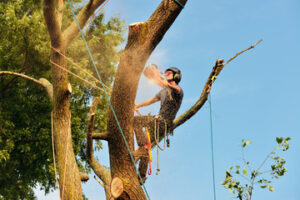The Importance of Tree Care
Trees need a lot of protection from storms, pests, and disease. A healthy tree will have bark that can’t be easily gouged or nicked.

A few key indicators of a healthy tree include one central leader, observable yearly growth, living branches, and no bare patches (on evergreens). Check for oozing sap or other signs of insect infiltration. Click https://www.prvtreeservices.com/ to learn more.
Tree planting requires a great deal of expertise and specialized equipment. Most municipal and county governments have laws requiring that all trees be planted by licensed professionals who understand the intricacies of proper planting and care for new and young trees.
The ideal planting site is free of weeds, trash, and other debris that can contaminate the soil. The area should also be fenced to prevent animals from digging up newly planted trees.
After planting, the soil should be raked to remove large rocks and roots. Then, a layer of natural wood chip mulch should be spread around the tree’s base, 4 inches from the trunk and 6 inches thick. That conserves water, helps to control weeds, insulates the soil from extreme temperatures, and allows key nutrients to penetrate the ground more quickly.
Keeping the soil properly hydrated is essential by watering the tree at least once a week (barring rain) and more frequently during hot weather. The water needed depends on the climate, soil type, and tree species. It is important to avoid over-watering as this can be just as harmful to the newly planted trees as not watering enough. Using a drip system to deliver slow, deep water is a good option as it reduces the chance of overwatering.
In addition to the benefits we get from trees, such as shade, beauty, and property value, they are also very important to wildlife. Trees provide shelter, food, and nesting sites. Even dead or dying trees, known as snags, offer food and shelter to various small mammals and birds.
When a tree grows out of control, it may need to be pruned to avoid safety hazards. That includes branches that rub against power lines or a home’s roof and limbs too close to sidewalks and roadways. Regular pruning also helps trees and shrubs maintain their health, shape, and structure.
Several pruning methods include crown thinning, topping, raising, and reduction cuts. Crown thinning is a pruning process that reduces the density of a plant’s canopy to improve light penetration and manage growth. It’s often performed on young trees to encourage the formation of a single leader, which will help reduce future problems.
Pruning removes dead, diseased, broken twigs or branches and crowded or crossing limbs. When trimming is done correctly, it promotes the overall health of a tree while enhancing its appearance and value to your property.
It’s important to consult a gardening resource in your area to determine the best times of year to prune specific trees and plants. In addition, it’s essential to consider safety when working with pruning equipment. Always wear a long-sleeve shirt, gloves to protect your hands, and protective eyewear. Some shade and flowering trees tend to bleed or excrete sap when cut, so they should be pruned after the leaves have matured. That minimizes bleeding and the chance of stinging insect infestation.
Watering is one of the most important aspects of tree care. Whether using a hose, sprinkler, or even a bucket, water should be applied so that it seeps into the soil around the tree’s roots. Adding mulch to the ground can also help absorb the water, allowing the earth to retain moisture.
Newly planted trees should be watered as often as 2-4 times per week, especially in dry weather. That will increase during the summer when they are actively growing. After planting, water the tree until the root ball is saturated and let it dry slightly before watering again. Newly planted trees exposed to drought-like conditions and those damaged by storms or digging should be monitored closely and watered regularly.
During the spring, the tree needs about an inch of rain every week for proper growth. If you are using a hose to water, make sure it is set up so that the water trickles out all along the length of the hose and not just in a gush. That will ensure that the entire root area gets a chance to absorb the water. Watering the soil, not the leaves, is recommended, as this will benefit the plant the most.
As pollinators, decomposers, predators, and food sources, insects are vital to natural, agricultural, and urban ecosystems. Insects are also important pests in agriculture and forestry and vectors for disease.
To thrive, insects must have the right conditions. These include an appropriate enclosure, a place to hide when threatened or rest, and the right food. Insects are nature’s recyclers, breaking down dead plant material into simpler substances that primary producers can use. In addition, many insects are essential to ecological processes such as soil structure and fertility, seed dispersal, insecticide control, and nutrient cycling.
Some insects directly damage trees and shrubs, including leafhoppers, which leave behind ragged holes in leaves, borers that infiltrate the vascular system, and caterpillars, which can defoliate an entire tree or shrub. Cultural controls (such as proper watering, mulching, pruning, and avoiding excessive fertilizer) help reduce insect populations. Limbs and removing them from the ground prevent the caterpillars from emerging to feed on new growth.
Some insecticides, such as the organophosphate malathion, are useful for controlling damaging insects without affecting beneficial insects. Horticultural oils, such as horticultural oil or acephate, are another effective control method. These sprays are rubbed into the stems, foliage, or bark of the plants and absorbed by the foliar tissues, where they cause insecticidal action. Dormant oils are best applied in early spring before buds swell.
Tree diseases are conditions that affect the health and growth of trees. Several things can cause them, leading to serious problems if not treated in time. Luckily, there are ways to prevent many of the most common diseases. Keeping trees healthy with proper pruning, soil care, fertilization, and watering, and limiting damage to bark from mowers and other tools can help reduce the risk of infection.
Many diseases are characterized by a loss of rigidity and wilting or yellowing leaves, though symptoms vary depending on the disease and host species. Bacterial infections may cause a distinctive tan or white ooze that appears on the bark and twigs, while fungal diseases often result in scars of dead leaf areas on the foliage or stems of the plant.
Taking the time to monitor your plants and identify any unusual changes is essential for good plant health. Stunted growth compared to normal for the species, drooping or bare branches, and abnormal swelling at the base of the trunk (at the ground line) can all indicate that a disease is present. If not identified and treated early, these issues can cause severe structural damage to the tree and pose safety hazards for people and property. If you suspect your tree is infected, immediately contact a tree expert to seek treatment. They will be able to identify the problem and recommend appropriate treatments.
While a beautiful, thriving tree adds to property value, dead or dying trees are less attractive and can significantly reduce property values. Plus, they can be a safety hazard and may attract pests, like rats and termites, that can damage the surrounding home, business, or other structures.
Removing sick or dying trees before spreading their infection to surrounding trees is important. It is the same as a rotten apple: if one tree becomes infected, it will likely pass the disease on to other healthy trees and shrubs. Therefore, inspecting your trees regularly and acting as soon as you notice any signs of illness or infection is crucial.
Another reason to remove unhealthy or dying trees is to prevent them from falling over and causing damage in stormy weather. Isolated trees are more vulnerable to hurricane and wind damage because they lack natural protection from nearby plants and buildings.
In most cases, the health of a damaged tree can be restored through pruning and other care techniques. However, it may be necessary to remove a tree if the damage is beyond repair or if it poses an immediate threat to your property. Look for the following indicators that a tree needs to be removed:
